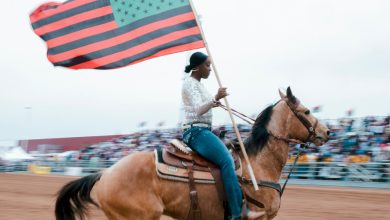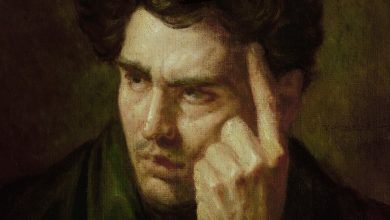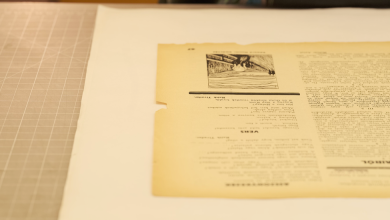‘Vivian Maier Developed,’ an Intimate Biography of a Very Private Photographer

If a picture were still worth a thousand words, we’d know more than enough by now about Vivian Maier, the so-called photographer nanny whose vast trove of images was discovered piecemeal and not fully processed, in all senses of the word, after her death at 83 in 2009, just as the iPhone was going wide.
Long before we were all carrying around those little wafers of pleasure and misery, Maier made constant companions of her Brownies, Leicas and Rolleiflexes. The ensuing record of her wide-ranging movement throughout the world — at least 140,000 negatives of landscapes, common folk, celebrities, children, animals and garbage — has more range and rigor than any influencer’s. Despite recurring selfies, some in noirish shadow, Maier was in fact the anti-influencer: Her startling compositions were not only largely unshared and unsponsored during her lifetime — she made abortive attempts to start a postcard business — but almost entirely unseen.
Their posthumous airing, and an ecstatic popular reception that began on the internet, has kept critics, lawyers and scholars busy.
A biography by Pamela Bannos published in 2017 suggested that the ragtag assortment of men who had unearthed and to some extent profited from Maier’s photographs — buying and selling them at auction, organizing popular exhibits and producing books and documentaries about her — were presumptuous to frame her story, let alone lay claim to it. (Maier is thought to have been deeply suspicious of men, as a general rule; she warned her young charges against sitting on their laps, and once so forcefully “decked” a guy trying to be helpful that he got a concussion).
A new biography, by Ann Marks, a former corporate executive with a background in analyzing “everyday people,” rejects this idea of exploitation. The book seeks to gently restore credit to those who put the photographer on the map — principally John Maloof, a real estate agent-turned-artist whose film “Finding Vivian Maier” was nominated for an Oscar. (Maloof seems to have emerged the intellectual-property victor from a nightmarish thicket of international copyright issues and competing advocates.) Marks believes Maier would have been pleased to be on that map, despite a life of obscurity that at times veered into squalor.
The difference of perspective may be moot. Just as you can’t libel the dead, you can’t ascribe intent to them; especially if, like Maier, they didn’t leave a will or outline their wishes to any intimates or have intimates.
Even those who employed Maier as a governess (“nanny” seems altogether too soft a term for her) and gave her rooms in their homes considered her strange, if not downright sinister in retrospect. Dodgy with references, occasionally resorting to corporal punishment and dragging minors around as she shot subjects such as naked mannequins and sheep marching to their slaughter in questionable parts of town, Maier would never be hired in our era of background checks, hyperscheduled activities and five-star reviews on care.com. (She was exceptionally loving to three boys in Chicago, the Gensburgs; they reciprocated by helping her in old age, eventually arranging to scatter her ashes in a forest preserve where they’d once picked wild strawberries. She also babysat briefly for Phil Donahue after his divorce, recording his broadcasts and later framing an article “featuring his proclamation that women were underestimated in television.”)
Parachuting into families with a spit-spot on-the-double briskness, Maier was inevitably compared to Mary Poppins or, zooming around on her moped, the Wicked Witch of the West. I flashed also on Ole Golly in “Harriet the Spy,” with her somewhat mannish affect, militaristic walk in clunky shoes and straight talk. Maier often costumed and characterized herself as a sort of spy.
Marks, with access and permissions that Maloof had denied to Bannos, tells Maier’s life with the intimacy of a scrapbook — and, at various points, the sanctioned intrusiveness of a detective log. Readers see Maier’s Liberty print blouses arrayed — she was an avid and discriminating shopper — and one of those big shoes measured. They learn of her odd grooming habits: washing her hair with vinegar and coating her face in Vaseline. And of her collections: Once her stack of newspapers, a major preoccupation, grew so heavy it buckled the floorboards.
Such hoarding, Marks convincingly argues, was a sign of mental illness, a likely solution to the supposed mystery of Maier’s extreme privacy that should be fully aired and destigmatized, rather than shrugged off as mere eccentricity. “If Vivian had battled cancer, or even lesser physical afflictions like tremors, arthritis or lazy eye, these conditions would not have been dismissed as irrelevant to her photography,” she writes. “She would likely have been lauded for her fortitude in moving forward in the face of disability.”
Eager to follow this theory throughout the Maier bloodline, Marks sometimes displays the indiscrimination of that relative who has gone giddy on ancestry websites, tracing lineage until it blurs beyond recognition. “For me, no detail is inconsequential,” she writes in her introduction. Uh-oh, I thought. There and in multiple appendices describing research methods and roadblocks, she shows her work maybe a little overmuch.
But the bulk of “Vivian Maier Developed” is a thorough, fascinating overview of an artist working for art’s sake, and a forceful case for further exposure rather than discretion in the name of kid-gloved pity.
To add my own appendix: Marks’s selection of photographs, artifacts and documents is judicious and satisfying, but the book’s format reduces many to small squares. Bring a magnifying glass.




